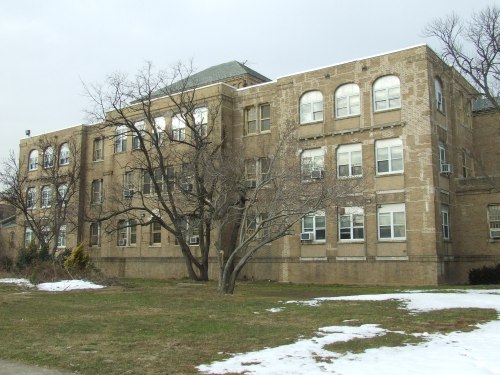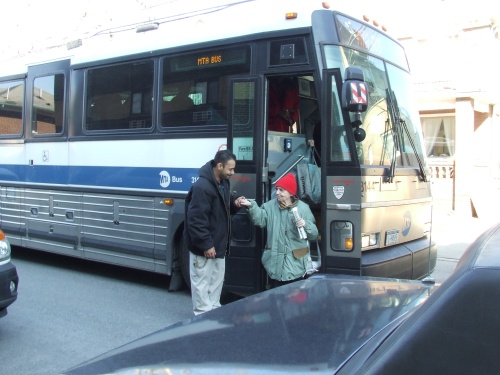
On Valentine’s Day, “Miriam” gets a hand and a smile exiting the bus that brought her home after living in shelter for over three months.
Having a moniker like “Kiki Valentine” makes every February 14th especially poignant since it’s the day that best represents – despite its deeply-based roots in what I like to call “Catholic gore” – love and all that it means. This year, I have the gift of reflecting on the wedding ceremonies I wrote and officiated, the bringing together of two lives in a sense and ceremony of traditional love. I’m so glad I have had those experiences. What can I say? I love love.
Another great personal love story is the sordid tale of a population of just over 100 elderly and disabled Hurricane Sandy evacuees from Belle Harbor Manor in Far Rockaway, Queens whom I met while volunteering at the Park Slope Armory’s temporary medical shelter last October. The first overnight I volunteered, I planned on being there for four hours but instead I stayed until eight the following morning. I just couldn’t leave if I knew I could help a few more people; most volunteers would leave each night after midnight, leaving a true skeleton crew to assist, walking the rows, flashlight in hand, to see if anyone was awake and had any needs. In the days that followed, I spent hours in the dark sorting, organizing and distributing clothing donations. That was a really great way to connect with people, they would come up to the fenced-in area, tell me what they needed, and I was, basically, a “personal shopper” for them, since I knew best what colors and sizes were available. I cut the fingernails of patients (because the nurses weren’t allowed to). In fact, out of all of the supplies and medical support in the shelter, there were no nail clippers anywhere. During the Nor’Easter following Sandy, I set out in the snowstorm to find some. The man whose nails I cut that night, Eddie, is a resident of Belle Harbor Manor and it turned out we have a mutual friend in common from the ‘old neighborhood”, Red Hook.
During the course of November, I bought so many pairs of mens and womens underwear I lost count. I spent overnights armed with latex gloves and a flashlight sorting donations and taking blind people to the bathroom in the dark, amazed that my usually fragile sense of smell had somehow strengthened to be able to keep on going. Only one night did someone’s “accident” cause me to uncontrollably gag, and that was when I was reminded of how amazing nurses are. I learned about the magnificent glory of “chucks”, which are basically giant blue absorbent pads placed onto wheelchairs in the event adult diapers leaked. There were a lot of pathogens involved with volunteering, and odors – especially when the shelter was operating at full capacity with 500 patients. Since the Armory is a gymnasium, all of the cots were arranged within the indoor track, so my slapstick wheeling of patients along the track allowed for some comic relief. Later I moved, in the rain, with residents from shelter to shelter, transporting them with Zipcars, in times of need, and staying with them past visiting hours if they asked me to. I fed them, clothed them, secretly brought them donuts and coffee and have spent countless hours on the phone with the OEM, Department of Health and FEMA on their behalf,sometimes speaking high school Spanish, or attempting, as I needed so desperately at times, to channel the ability to speak Chinese to help them file their claims (it didn’t happen). I made a lot of calls to friends in very high (and very low) places to lend a hand, and as a result small amenities like a daily newspaper delivery ended up changing a lot of people’s lives. Throughout, I have been forced to consider the way that we, as Americans – and as New Yorkers – treat our aging population. And during my journey what I discovered incensed me.
After the first three weeks, when 350 other residents were discharged from the Armory, I knew that I was making an invisible commitment to make sure they were “okay”. Little did I know they would need a lot more help then I or anyone could ever imagine. After the first six weeks, they had lived in three separate shelters which, each time, meant that several garbage bags full of belongings (donations obtained from myself and others) would be lost. Seven weeks after the storm they were still sleeping on “Army cots”, and a ramshackle team of volunteers, advocates, and caring humans did all they could, called everyone they knew might be able to help, and change eventually started to occur. A check from the Attorney General was signed, beds were delivered (just in time for a quasi-outbreak of bedbugs).
On the heels of the shooting back home in Sandy Hook and a truly cheerless holiday, on Christmas Day I decided to advocate full time for Belle Harbor Manor’s residents, and, for the past 106 days of our lives, I have been part of one of the greatest love stories I have ever known. Full of hope, optimism, and scandal – as any good love story is – in the end, after all of the dead ends that I somehow bulldozed through, after getting lost in Queens in the dark and the drives home in tears calling anyone I could think of who might help (thank you Allen Salkin), I have to laugh about the fact that I was not once but twice kicked out of the psychiatric hospital residents were sheltered in.
The first day residents were transferred to the Creedmor Psychiatric Campus, I was told that I had to be credentialed and complete a background check in order to be on the property, of which I attempted to initiate while stalling on the phone with ICL Senior management. I didn’t want to lose access to them in this institution. It was more ike a prison than a hospital, and it felt like there was much dark energy throughout. The VP of Bologna eventually told me, with security standing over me trying to get me out, that she couldn’t do anything about the site administrator’s decision. Leaving there that day, I asked the receptionist for a pen, to which she began reaching for each pen on the counter to move it from my reach. Sadistic, sociopathic. I didn’t want to imagine how these residents would be treated. For the first time in my life I uttered the words, “You don’t know who you’re fucking with” and think I lived up to it.
I also somehow narrowly escaped the risk of contracting both bed bugs and scabies, two events which sent other volunteers directly to the pharmacist and into an alarmed spin that included some medication, a lotion, that you slather on and sleep in. The point of this rather unpoetic stream of consciousness is that these residents, in all of their shining diversity, have made me reevaluate who I am as a person and what my purpose as a human in this life at this time really means. They have encouraged me to think outside the box, ignore stereotypes, exercise patience, to not fear mental illness, to overcome a weak sense of smell, to continue to stand up for what is right, to keep on asking questions, to be a better cold caller, to overcome insurmountable obstacles (any dealings with politicians excluded) and challenges, to connect with other like-minded people who also really care about others, and to develop a sense of strength I had long forgotten that the seed of was within me. All of this motivation and impetus wasn’t always direct or painless, and it certainly was not planned. After the overwhelming experience of being in the Park Slope Armory that first night, I kept going back. I could not leave these suffering strangers. Besides, I didn’t have electricity or heat at home, we had an eight-foot storm surge. People – especially my family – have asked why I had gotten myself so involved, and I didn’t have an answer; I simply followed my heart.
It was anguishing to know that this aging and disabled population, most with no family or support, were left to suffer and be the pawns in a struggle between the City of New York and the State of New York’s Department of Health, and that they were paying upwards of $1900 in rent each month to live on the campus of a remote psychiatric hospital in Queens. I often found myself wondering,”If not for us, who will help them?” Certainly not the long list of “burned out” professional case workers I encountered, fighting their own fights against what was right (humanism) vs. what they were being told to do (red tape). There was anger and strife throughout, for the residents, for the volunteers, for the staff, for the journalists. And yet from all of this, compassion, friendship and love were born. To me, the strange but beautiful part of the story is that of all the shelters residents found themselves in, if given the choice to return to the setting the Armory provided, every single one of them says they would rather be there than, shockingly, back home at Belle Harbor Manor.
There are so many people I wish to thank, and I will attempt to do so in the event they are, like me, set up with Google Alerts for themselves. In the meantime, I plan on writing more about this. The harsh reality is that my relationship to these people isn’t over once they return home. They still have needs. Many are the victims of looting. Their belongings and cash, thought to be safely locked, needing replacement. Social security cards, passports, green cards, and more. I am set to look at the long-term disaster relief and planning required for others like them. I will again need to make those calls and send email to others who might be able to help me be of better service to others. For now, however, I will sleep tonight, relieved for the first time in 107 days. This what love looks like to me this Valentine’s Day. Home. I have tears in my eyes just thinking about how many people have touched my life since this storm washed away all of my fear. Thank you.
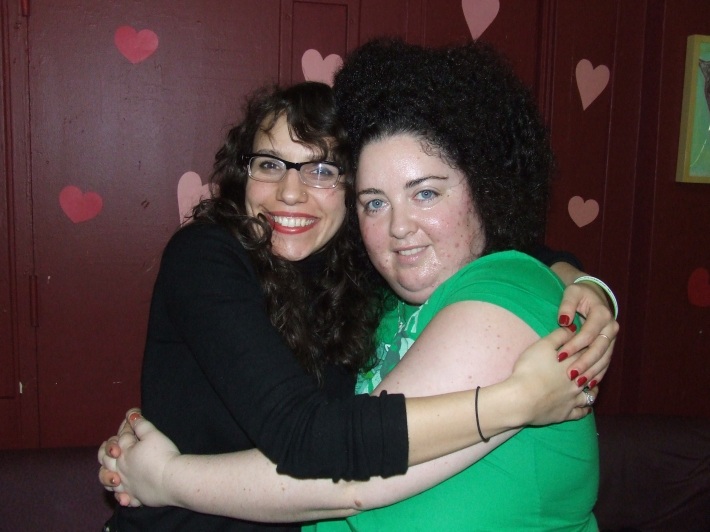
“If your name is Kiki then I’m changing my name to ‘Voodoo'”, she said. And from then it was clear that despite our differences, we would be friends. Today was our goodbye to shelter #3, Creedmor (although she did like the free use of computers, stating, “There is so much information on the Internet! I need to get a computer of my own!”
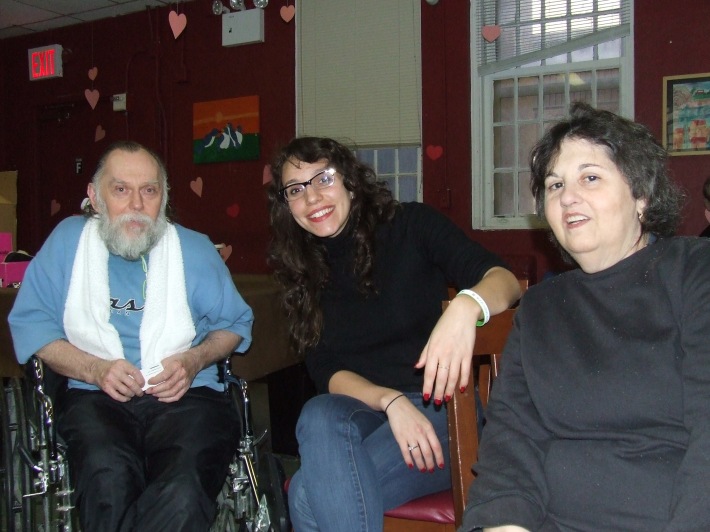
To my left, Tom Fortune, who, while at the Armory on my overnight rounds, never asked me for anything. I went on this wild portable radio shopping obsession because I felt it was critical that while in shelter, people should be able listen to the news, or most importantly, to music, to feel connected with what we would later refer to as “the outside”. When I brought the radio to him, he in his wheelchair on the four lane track amongst a population of 500, he said “Give it to someone who needs it.” I replied, “But I got this for you.” Here we are 106 days later and he says, “Of course we’ll stay in touch. I’ll call you every time my radio runs out of batteries.” To my right, the sweet and caring Donna Rubin.
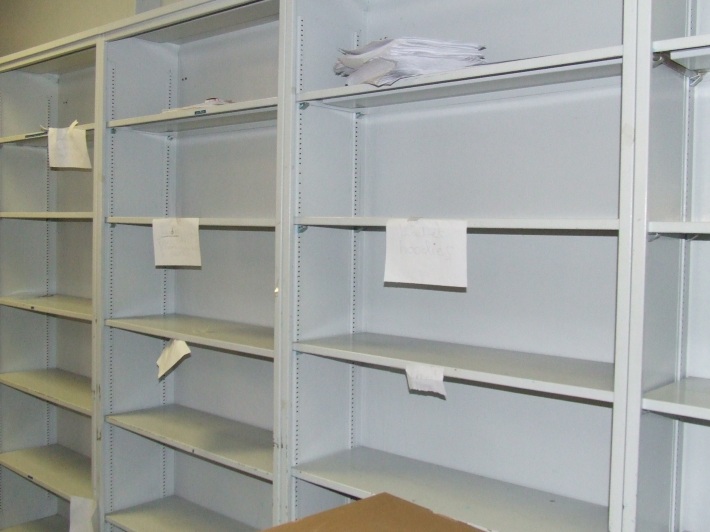
After the donation sorting and organizing at The Armory (an enormous undertaking every night), the library at Milestone Residence at Creedmor Psychiatric Hospital is transformed into a donation center. Now, the shelves are bare and belonging, transported in black garbage bags similar to those the residents were living out of, have returned “home”.
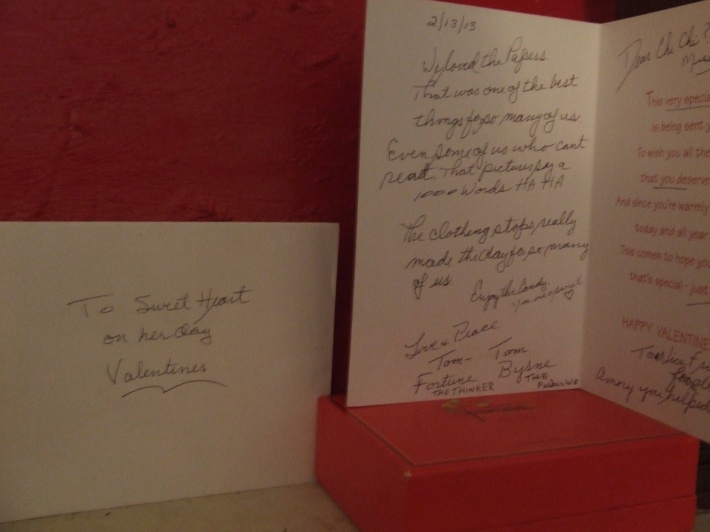
When I received this card and opened it, I felt that the hours of sacrifice and hard work were somehow able to culminate into this one simple and unexpected thank you. Just touching to the 1,000,000th degree.
THANK YOU (in no order and I am hoping I haven’t forgotten any/many):
The residents and staff of Belle Harbor Manor
RI-1 DMAT
Ali Hodin-Baier, Aging in New York Fund
Amy Parsons, The American Red Cross (and now, a friend)
Jake from the Washington Conservation Corps
Caron Atlas http://www.artsanddemocracy.org
AmeriCorps team members
The Amory volunteers
The Kings Hotel volunteers
The Creedmor volunteers
Casey Shea
Nicholas Verburgt (Express Men’s sock donations)
Maria Provenzano and the CenterLight staff at Kings Hotel
Amy Glosser, CERT & online volunteer infrastructure developer
Meryl Blackman
Justin the FEMA inspector
David Caruso, The Associated Press
Doug Kuntz (do gooder, photographer, rabble rouser)
Brett Cotter http://www.stressbegone.org
Laura Black, NYC OEM
JK Canepa, CIAD
Geoff Lieberman, CIAD
Amanda Bickerstaff, UWS Loves
Suzanne Windland, SNAP & all that she has done and continues to do!
Christina Komploris, NY Post/WSJ donations
Richard Shults Jr., NY Post/WSJ donations
Andy McCallihan, NY Post/WSJ donations
Jill Cornell, donations and all of her work in the Rockaways
JC Hopkins, volunteer and transportation!
Pam Koner, mobile phones for residents
Jerry Probst, FEMA inspector and encouraging, awesome soul
Felice Steele, The American Red Cross (and also a diligent do-gooder!)
Maureen Italiano, ICL Milestone staffer who challenged me
Larissa, ICL Milestone staffer who really cares about people
Brad Lander, City Councilman & Staff
Joseph Ger Ph.D, BCBA-D
Brad Harrelson, The American Red Cross, Texas (helped connect family members)
Nannearl Blackshear, Brooklyn Borough President’s Office
Lynda Lowe, FEMA
Peggy Mott, FEMA
Krystal Reyes
Oswald Ramsammy, NY Times donations
Justin Silverman, connections to newspaper donations
Christine Kessler (helped us find a lost resident)
Marina Tsamplina, NY Helps NY
Megan Byrn
Parker Tracey and Dave Escovitz at Char No. 4 who covered shifts for me so I could help
AND TO EVERYONE who donated!
Dave Ankers
Dennis and Jeni Espantman
Lael @ FIND Home Furnishings, Brooklyn
Duben Canales & Jasmine Heikura
Keara Driscoll
Maria Esther Hammck
William Groner
Kristina Kroger
Selma Kalousek
Beezlebabe Siren
Margaret Welch
Karen Cowdell
Annie Chambliss
Jay Christensen
Simon Durkin
Farzin Lofti-Jam

